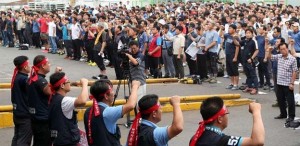Labor trouble continues to hobble production at both Kia and Hyundai, according to new reports from South Korea.
Both Kia and its South Korean partner, Hyundai, are seeing their market share reduced this year because of vehicle shortages that have been attributed, at least in part, to sporadic labor disputes at South Korean factories. Executives at both Kia and Hyundai have acknowledged vehicle shortages have reduced inventories and made it more difficult to keep up with the growing global sales.
Saturday production was halted in March at two of Kia’s three assembly plants in South Korea and at all plants of its larger affiliate Hyundai , amid union protests over a new shift structure. The weekend shifts resumed in May at Hyundai and in June at Kia, after some management concessions.
However, the Saturday walkouts resumed last month at Kia, which is attempting to grow not only in the U.S. but also in markets such as Great Britain and Russia, the company told the Financial Times. Kia had not previously confirmed the renewed disruption.
Unions at Hyundai and Kia last week voted in favor of a strike after annual wage negotiations failed to produce an agreement and staged a warning strike at Hyundai, which may have cost the company $76 million in lost production.
(Hyundai, Kia strikes could mean shortages for U.S. buyers. Click Here.)
An analyst at KB Investment & Securities estimated the loss of the Saturday shifts would result in lost output of up to $214 each month. Hyundai and Kia have typically managed to make up much of their lost production by using overtime, which raises their labor costs.
Over the past decade, Hyundai Motor Group – which comprises both Hyundai and Kia – has used aggressive marketing, tight cost controls and improved design to become the world’s fifth-biggest automotive group by sales. But shares of both affiliates trade at a discount to many of their peers in part because of investor worries over industrial relations.
(Kia’s hamsters strut the red carpet with help from Lady Gaga. Click Here for more.)
Labor disputes were particularly common in the 1980s and into the 1990s, with many turning violent. Both Kia and Hyundai operations in South Korea have suffered strikes almost annually over the years, with the exception of a three-year period between 2009 and 2011.

